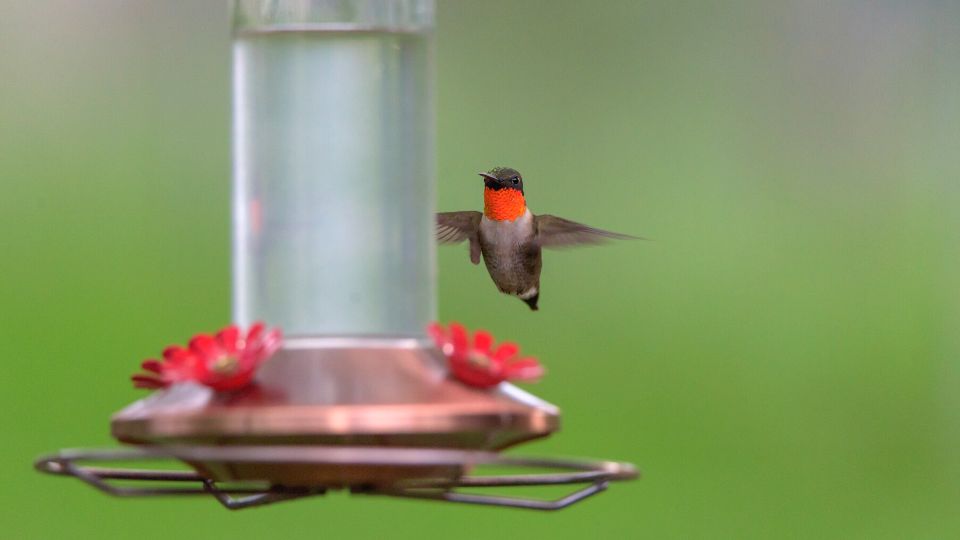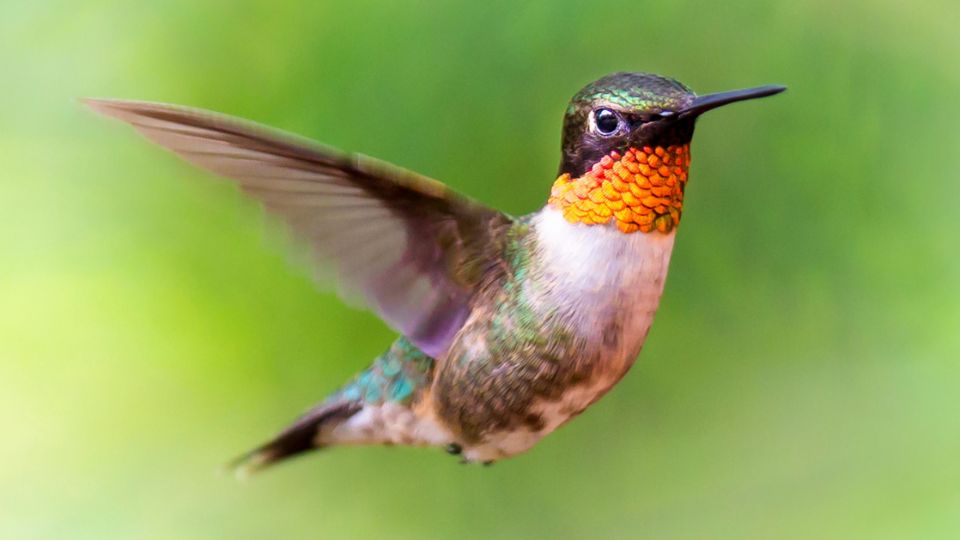Several species of hummingbirds spend the late spring and summer months in Montana. The Black-chinned Hummingbird, Calliope Hummingbird, and the Rufous Hummingbird are all common visitors to this northwestern state. Several other species are less common, with just a few yearly sightings.
There are over 320 different species of hummingbirds spanning from South America to Canada and Alaska. Many breeds migrate thousands of miles each way, including flying 500 miles straight across the Gulf of Mexico.
Hummingbirds in Montana enjoy feeding on native plants, breeding, and nesting in coniferous forests. Read on for more information about the species of hummingbirds in Montana and how to attract them to your space!
Table of Contents
Species of Hummingbirds in Montana

Black-chinned Hummingbird (Archilochus alexandri)
Black-chinned hummingbirds are spotted between May and September. After breeding, they often move higher in the mountains to feed on flowers before migrating south for the winter.
- Range: Commonly found in the western United States; migrates to the southern US during the winter
- How To Identify: Males are dull metallic-green with a white underbelly. They have a black throat (gorget) with an iridescent purple patch underneath. Females have a pale throat area with white tips on their tails.
- Habitat: Black-chinned hummingbirds enjoy canyons and rivers. They often perch at the tops of tall, dead trees.

Calliope Hummingbird (Stellula calliope)
The Calliope Hummingbird is one of the tiniest birds in the US. These tiny birds weigh less than a penny.
- Range: Calliope hummingbirds breed in the western US during the summer and spend the winter in the southeastern US, near the Gulf of Mexico.
- How To Identify: Male calliope hummingbirds have a red or purple gorget and a short tail. Females are a light pink underneath.
- Habitat: Found mostly in conifer trees, Calliope females typically build their nests in forks of branches.

Rufous Hummingbird (Selasphorus Rufous)
- Range: From southern Alaska down the Pacific Coast
- How To Identify: Male rufous are bright orange-colored. They have a white patch on their upper belly and rust-colored feathers on their sides. Females have a greenish-brown back and sides but the same rusty orange on their sides.
- Habitat: Rufous hummingbirds prefer mountainous forests with plentiful flowers
The rufous hummingbird breeds farther north in the US than any other hummer—from southeastern Alaska down to California and even east as far as Montana. The rufous hummingbird winters near the Gulf of Mexico.
Though hummingbirds normally lay two eggs at a time and raise those young before mating again, occasionally, female hummingbirds will have two active nests at one time. Both the Calliope and Rufous Hummingbirds were observed exhibiting this behavior in Montana.
Less Common Montana Hummingbirds

Anna’s Hummingbird (Calypte anna)
Anna’s Hummingbirds are known for their heroic courtship dives—male Anna’s fly as high as 130 feet and dive down towards the female, making a noise with their tail feathers.
- Range: Found commonly in California, Anna’s Hummingbird is beginning to expand to other western states, including Arizona and Washington. There have been a few sightings in western Montana.
- How To Identify: Anna’s Hummingbirds are mostly green and gray. Males have a red-pink head and gorget, while females have a gray throat with red spots.
- Habitat: Anna’s hummingbirds enjoy backyard feeders as well as tubular flowers in bright colors. They prefer to nest high in trees.

Broad-tailed Hummingbird (Selasphorus platycercus)
Broad-tailed Hummingbirds feed from native plants as well as backyard feeders. Broad-tailed hummingbirds perform u-shaped dives in an elaborate courtship ritual, hoping to entice a female hummingbird to mate with them.
- Range: Very common near the Rocky Mountains; breeds from Wyoming to Idaho and down to central Mexico; found mostly in southwestern Montana.
- How To Identify: The male Broad-tailed has a bright pink gorget and a white breast. Females have green spots on their cheeks and throats.
- Habitat: Broad-tailed Hummingbirds prefer woodlands and mountain forests, choosing higher elevations between 5,000 and 10,000 feet.

Ruby-throated Hummingbird (Archilochus colubris)
The Ruby-throated is the most common hummer in the US. It’s the only hummingbird species that breeds east of the Mississippi River. Though not as common in Montana, there were sightings in 2021.
- Range: Spending their breeding season in the US, Ruby-throated Hummingbirds migrate yearly from central Mexico. They fly 500 miles over the Gulf of Mexico to migrate for the season.
- How To Identify: Male Ruby-throated Hummingbirds are known for their ruby-red throat. They have iridescent green feathers and a white underbelly. Females are duller green with a dirty white underbelly and white gorget.
- Habitat: Ruby-throated hummers are frequent visitors to backyard hummingbird feeders. They live in nearby trees, feeding from flowers in the area.
Vagrant Species Spotted In Montana
Costa’s Hummingbird (Calypte costae)
Females tend to build their nests lower than other species, usually 3-7 feet off the ground.
- Range: Costa’s hummingbird lives mainly in Baja, California, southern California, and western Arizona. They migrate to Utah, parts of Nevada, and California for breeding grounds.
- How To Identify: Males have an iridescent purple gorget and crown. They have green back feathers and a white belly. Females are similar in color but lack the purple throat and crown.
- Habitat: Costa’s hummingbird prefers mountainous scrub plants and forests.
Rivoli’s Hummingbird (Eugenes fulgens)
Rivoli’s Hummingbirds are extremely rare in Montana. They were only spotted in 2019 in East Glacier Park Village.
- Range: Rivoli’s Hummingbirds stay mainly in Mexico and Central America. They can travel north to Arizona, New Mexico, and parts of Texas.
- How To Identify: Rivoli’s are larger hummingbirds. The male has an iridescent purple crown and throat. Males are green, and females are a duller green with gray underneath.
- Habitat: These hummers live in pine-oak forests and occasionally visit backyard feeders.
How Long Do Hummingbirds Stay In Montana?
Hummingbirds stay in Montana from mid-April to mid-September. Some hummers leave by mid-June, but many stays throughout the summer. Before their fall migration, hummers put on a layer of fat to help sustain their body during their long flight.

How To Attract Hummingbirds
Hang Feeders
The best way to ensure hummingbirds come to you is to hang hummingbird feeders. Keep them filled with fresh nectar. You can make your own with water and white table sugar.!
Plant Native Plants
Montana hummingbirds enjoy plants native to the western US. Tubular flowers with bright colors, including
- Columbine
- Salvia
- Bee Balm
- Fireweed
Hummingbirds have long bills and can get nectar from inside flowers like these with long tubes. While other pollinators might not be able to get deep inside these flowers, hummingbirds can!
Planting flowers will invite bugs and other pollinators into your space for hummingbirds to feed on. Hummers eat various small insects, including gnats, beetles, and ants.
What Time Of Year Do Hummingbirds Come To Feeders?
Usually, hummingbirds arrive in Missoula County or the Flathead first. Between mid-April and mid-May, hummingbirds reach Montana during their spring migration. The males arrive first and look for food sources. Female hummingbirds arrive a week or two later, and the breeding season begins.

Hummingbirds: Quick Facts
- Hummingbirds are native to the Americas
- They make up the biological family Trochilidae
- Hummingbirds eat up to three times their body weight to sustain their fast metabolism
- Hummers eat nectar from backyard feeders, as well as small insects
- Hummingbirds enter torpor at night to save energy
What Time Of Year Are Hummingbirds Most Active?
Hummingbirds are most active in warm weather because of their quick metabolism. They migrate north, breed during spring and summer, and back south for the winter.
What Are The Colors Of The Hummingbirds In Montana?
Montana hummingbirds range from vibrant green to bright orange, with males wearing the most colors. Males are often distinguished by the color of their gorget or throat patch, which can be violet purple, bright red, or magenta. Females are usually duller in color and, more commonly, are colored muted green or dirty white.

